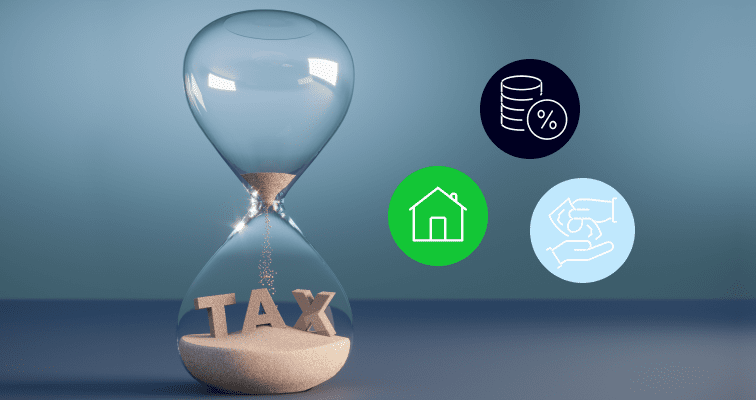When you sell assets, returns may be liable for capital gains tax (CGT). Find out what CGT is, how it works in Spain, and what it means to you as an investor.
Investing has been made easier and more accessible by online brokers that offer a user-friendly and cost-effective trading platform, allowing users to engage with capital markets in minutes. While this process is straightforward, in the case of returns, investors in Spain must also consider capital gains tax (CGT).
Calculating CGT liability involves assessing the difference between the initial expense incurred at purchase and the revenue received upon sale. Understanding how Spain’s CGT works is important, as the way that your trading activity is treated by the Spanish tax authority, Agencia Tributaria, can impact your investment decisions. This guide aims to simplify your investment journey and help you to reach your financial goals by explaining how to calculate CGT, and exploring potential strategies to reduce your CGT tax burden.
What is capital gains tax (CGT)?

In Spain, buying stocks, financial instruments or capital assets such as property may lead to a “capital gain”. CGT is a tax that is incurred on capital gains. It applies to various assets, including shares, property or antiques. If your trade has made a loss, it will not be liable for CGT.
The fundamental rule is that if you sell an asset at a price that is higher than what you paid for it, then you could be liable for CGT.
It is your obligation to understand how capital gains tax works in Spain and make appropriate filings to the Agencia Tributaria, as incorrect or non-payments may be liable for fines. The Agencia Tributaria website has all the information to help you, as an investor, find, complete and send the report.
Tip: Keeping accurate records of your trades will help you to navigate the CGT system, and identify opportunities to reclaim tax.
The amount of capital gains tax that you pay is dependent on numerous factors, shaped by both general rules and guidelines, as well as personal circumstances. Factors to consider include the duration of asset ownership, the nature of the assets, and whether you have accumulated any capital losses in the same tax period, which can be used to offset other capital gains.
What assets have capital gains tax?
It is important to know what assets are subject to CGT. While not an exhaustive list, here is a breakdown of some popular assets that are liable for capital gains tax:
- Shares and dividend income
- Exchange-traded funds (ETFs)
- Options, futures and warrants
- Mutual funds
- Bonds
- Cryptoassets
- Real estate
- Prizes
- Compensation
- Property damage insurance
- Some personal items, including jewellery, antiques and art
For active investors who regularly trade CGT-liable assets, getting advice from an experienced tax agent could be beneficial to ensure that you do not neglect any CGT liabilities, or overlook opportunities to reduce your tax burden.
How does CGT impact my other investments?

CGT is an integral part of investing. The most obvious impact on your portfolio is that returns will be lower than if CGT didn’t apply.
In Spain, CGT is charged not only on gains made by the price of shares going up, but also on dividend income, which might influence your investment strategy. Investing in dividend stocks may be less attractive in Spain than it is in countries where dividend income is not included in CGT calculations, for instance.
CGT considerations may also influence decisions on selling or transferring assets. Investors, particularly those over 65, can benefit from tax breaks by understanding the nuances.
For investors operating in the stock market, the most common CGT event is likely to be at the point where shares are sold, or dividend income is received from them. However, many more assets fall within the scope of Spanish CGT, and this means that regardless of what you trade, there is a need to accurately record all of your transactions.
How do I calculate my CGT?
Spain is not alone in taxing gains on capital investments, but the tax brackets are relatively more straightforward than in some other countries.
According to Article 33.1 of the Personal Income Tax Law, CGT applies to transactions where there is a capital gain, as well as donations of assets or economic rights.
The basic CGT tax bands, for residents of 183 days (six months) or more, are as follows:
| Profits | CGT Rate |
|---|---|
| Up to €6,000 | 19% |
| €6,000–€50,000 | 21% |
| €50,000–€200,000 | 23% |
| €200,000–€300,000 | 27% |
| Greater than €300,000 | 28% |
A CGT charge is only triggered when you sell an asset for a profit. Ensure proper processing by keeping copies of the following documentation, which will help you to establish your potential CGT liability:
- Tax declarations and statements
- Broker statements
- Bank and savings statements
- All documents relating to income tax, property taxes and business taxes
- House deeds and property transfer documents
- Work and salary documents
- Details of compensation payouts
- Insurance certificates
How can I minimise my CGT?

While you may not be able to avoid paying capital gains tax entirely, considering your personal criteria may help to reduce the amount of CGT you pay.
Consider offsetting expenses
When calculating the purchase and sale values of your transaction, factor in certain deductible expenses. These may include VAT, stamp duty, or legal and professional fees.
Use the tax calendar to your advantage
Some investors may opt to gradually liquidate profitable positions over an extended period of time, perhaps over multiple tax years, in order to keep annual capital gains below or within the lowest CGT threshold, and, therefore, leverage the lowest CGT rate of 19%.
Different types of transfers are taxed differently
Capital gains tax is not applied on transfers that are deemed “mortis causa,” meaning a transfer of property made in contemplation or anticipation of the death of the maker. On the other hand, “inter vivos” transfers made between living people (with no anticipation of death) are taxed at the full CGT rate.
Know what you are investing in
Dividends or profit-sharing income received by a Spanish company from a foreign firm may benefit from a 95% CGT exemption. This “imputation tax” can apply to those with a 5% interest in a foreign company during the 12 months prior to the date on which the dividend is payable. This results in a 1.25% effective tax rate. Various detailed requirements apply. This tax credit can be carried forward for an unlimited number of years.
Take advantage of capital losses
Not all trades post positive returns. Capital losses can be offset against taxable capital gains of a similar nature in the same tax year.
Speak to a professional
A tax agent experienced in overseeing the processing of investment returns can give you bespoke advice on how to process your tax filings and potentially reduce your CGT liability.
Final thoughts
Understanding and navigating capital gains tax (CGT) is crucial for investors in Spain to ensure compliance and potentially optimise returns. Maintaining accurate records of trading activities, engaging a tax advisor, and grasping the basic CGT rates can offer investors comfort that their affairs are under control. By learning from tax professionals, investors can devote more time to focusing on the golden rules of investing. After all, you don’t pay CGT on losing trades.
Join eToro today and learn more about CGT, investing in the financial markets, and trading in general.
FAQs
- What is the best way to keep track of my transactions and statements?
-
The financial institutions that hold your investments should issue tax reports detailing your transactions. If you’re using an online broker, you can expect the account admin area of the platform to contain the records you will require to complete a CGT filing, and some brokers generate tax statements for their clients. eToro, for instance, offers tax reports to their clients at the silver tier level and above. If you receive paper copies, then store those safely.
- How can I determine if my assets are liable for CGT?
-
It is important to establish which of your holdings fall within the scope of CGT, but this can be one of the hardest things to determine. Movable capital assets such as shares and bonds are long-established members of the group of assets to which CGT does apply. Matters get more complicated if there is a question of whether personal items such as furniture are considered antiques. Some assets such as property are taxed at different rates depending on whether or not it is your prime residence.
- Is the Plusvalia Municipal tax the same as capital gains tax?
-
No, the Plusvalia Municipal tax is different from CGT. There is some confusion caused by certain capital transactions falling within the scope of both of these taxes and the Plusvalia Municipal tax often being referred to as a municipal capital gains tax. The Plusvalia Municipal charge is applied by local authorities, and the CGT by the national tax office.
This information is for educational purposes only and should not be taken as investment advice, personal recommendation, or an offer of, or solicitation to, buy or sell any financial instruments.
This material has been prepared without regard to any particular investment objectives or financial situation and has not been prepared in accordance with the legal and regulatory requirements to promote independent research. Not all of the financial instruments and services referred to are offered by eToro and any references to past performance of a financial instrument, index, or a packaged investment product are not, and should not be taken as, a reliable indicator of future results.
eToro makes no representation and assumes no liability as to the accuracy or completeness of the content of this guide. Make sure you understand the risks involved in trading before committing any capital. Never risk more than you are prepared to lose.


